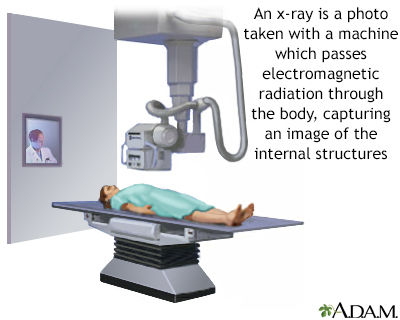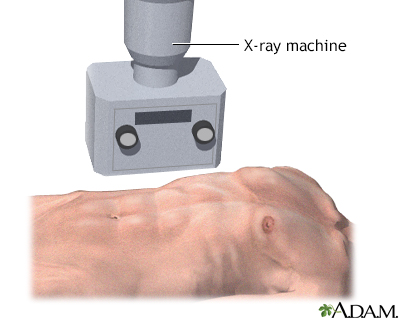X-ray
Radiography
X-rays are a type of electromagnetic radiation, just like visible light.
An x-ray machine sends individual x-ray waves through the body. The images are recorded on a computer or film.
- Structures that are dense (such as bone) will block most of the x-ray, and will appear white.
- Metal and contrast media (special dye used to highlight areas of the body) will also appear white.
- Structures containing air will be black, and muscle, fat, and fluid will appear as shades of gray.

X-rays are a form of ionizing radiation that can penetrate the body to form an image on film. Structures that are dense (such as bone) will appear white, air will be black, and other structures will be shades of gray depending on density. X-rays can provide information about obstructions, tumors, and other diseases, especially when coupled with the use of barium and air contrast within the bowel.

X-rays are a form of electromagnetic radiation, just like visible light. Structures that are dense, such as bone, will block most of the x-ray particles, and will appear white. Metal and contrast media (special dye used to highlight areas of the body) will also appear white. Structures containing air will be black and muscle, fat, and fluid will appear as shades of gray.
How the Test is Performed
The test is done in a hospital radiology department or in your health care provider's office. How you are positioned depends on the type of x-ray being done. Several different x-ray views may be needed.
You need to stay still when you are having an x-ray. Motion can cause blurry images. You may be asked to hold your breath or not move for a second or two when the image is being taken.
The following are common types of x-rays:
How to Prepare for the Test
Before the x-ray, tell your health care team if you are pregnant or may be pregnant.
You will need to remove all jewelry. Metal can cause unclear images. You may need to wear a hospital gown.
How the Test will Feel
X-rays are painless. Some body positions needed during an x-ray may be uncomfortable for a short time.
Risks
X-rays are monitored and regulated so you get the minimum amount of radiation exposure needed to produce the image.
For most x-rays, your risk for cancer, or if you are pregnant, the risk for birth defects in your unborn baby is very low. Most experts feel that the benefits of appropriate x-ray imaging greatly outweigh any risks.
Young children and babies in the womb are more sensitive to the risks of x-rays. Tell your provider if you think you might be pregnant.
References
Mettler FA. Introduction: an approach to image interpretation. In: Mettler FA, ed. Essentials of Radiology. 4th ed. Philadelphia, PA: Elsevier; 2019:chap 1.
Rodney WM, Rodney JRM, Arnold KMR. Principles of x-ray interpretation. In: Fowler GC, ed. Pfenninger and Fowler's Procedures for Primary Care. 4th ed. Philadelphia, PA: Elsevier; 2020:chap 235.
Version Info
Last reviewed on: 7/15/2024
Reviewed by: Jason Levy, MD, FSIR, Northside Radiology Associates, Atlanta, GA. Also reviewed by David C. Dugdale, MD, Medical Director, Brenda Conaway, Editorial Director, and the A.D.A.M. Editorial team.
